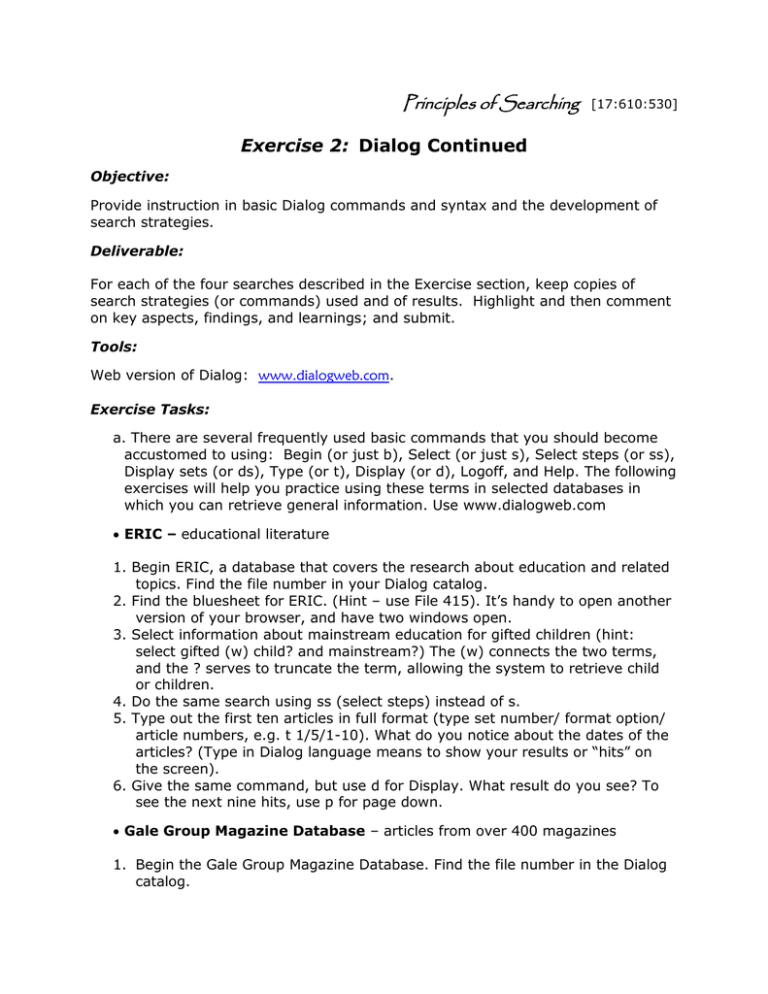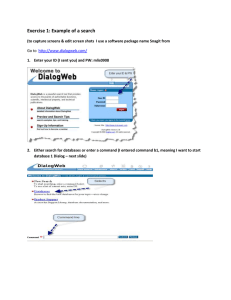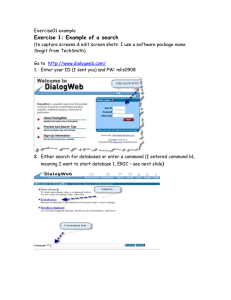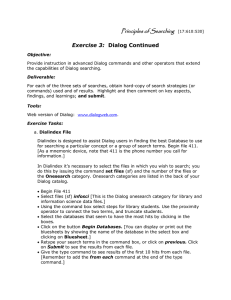Exercise02.doc
advertisement

Principles of Searching [17:610:530] Exercise 2: Dialog Continued Objective: Provide instruction in basic Dialog commands and syntax and the development of search strategies. Deliverable: For each of the four searches described in the Exercise section, keep copies of search strategies (or commands) used and of results. Highlight and then comment on key aspects, findings, and learnings; and submit. Tools: Web version of Dialog: www.dialogweb.com. Exercise Tasks: a. There are several frequently used basic commands that you should become accustomed to using: Begin (or just b), Select (or just s), Select steps (or ss), Display sets (or ds), Type (or t), Display (or d), Logoff, and Help. The following exercises will help you practice using these terms in selected databases in which you can retrieve general information. Use www.dialogweb.com ERIC – educational literature 1. Begin ERIC, a database that covers the research about education and related topics. Find the file number in your Dialog catalog. 2. Find the bluesheet for ERIC. (Hint – use File 415). It’s handy to open another version of your browser, and have two windows open. 3. Select information about mainstream education for gifted children (hint: select gifted (w) child? and mainstream?) The (w) connects the two terms, and the ? serves to truncate the term, allowing the system to retrieve child or children. 4. Do the same search using ss (select steps) instead of s. 5. Type out the first ten articles in full format (type set number/ format option/ article numbers, e.g. t 1/5/1-10). What do you notice about the dates of the articles? (Type in Dialog language means to show your results or “hits” on the screen). 6. Give the same command, but use d for Display. What result do you see? To see the next nine hits, use p for page down. Gale Group Magazine Database – articles from over 400 magazines 1. Begin the Gale Group Magazine Database. Find the file number in the Dialog catalog. Principles of Searching – exercise 2 2 2. Find the bluesheet for this database (hint: use file 415). 3. Search using select steps (ss) for articles having to do with library careers. Connect library and career with (w) as in the previous search. Use truncation. 4. Do the same search using the connector ‘and.’ What differences do you notice in the results? 5. Do the same search using select (s) instead of select steps. How do your results differ? 6. Give the command ds (display sets) to see your searching terms and results so far. 7. Consult the blue pages. How could you narrow down the number of hits you retrieve? PAPERS is the collection of newspaper articles that are available through Dialog. Note that you will be searching many newspapers, so you may want to adjust the way you type out results. You can also search individual newspapers. See the catalog. 1. Begin Papers. Since this is a DialIndex category, you can actually type in the word ‘Papers.’ 2. Search for articles on the play currently on Broadway where Hugh Jackman plays a lead role. 3. Begin the New York Times. How much of the NY Times is available via Dialog? 4. Open the Bluesheet for the New York Times. 5. Search for Hugh Jackman by his last name and then by his two names. Search for Hugh Jackman in the lead paragraph of articles. 6. Type out or display results and examine what you find. 7. Logout. b. Try a similar search on another database of your choosing. Wander around. Get lost…and try to develop understanding of the different fields and types of data that may exist in these databases. For each of the four searches, keep copies of search strategies (or commands) used and of results. Highlight and then comment on key aspects, findings, and learnings; and submit. Congratulations! You have successfully completed the second set of exercises in Dialog.







